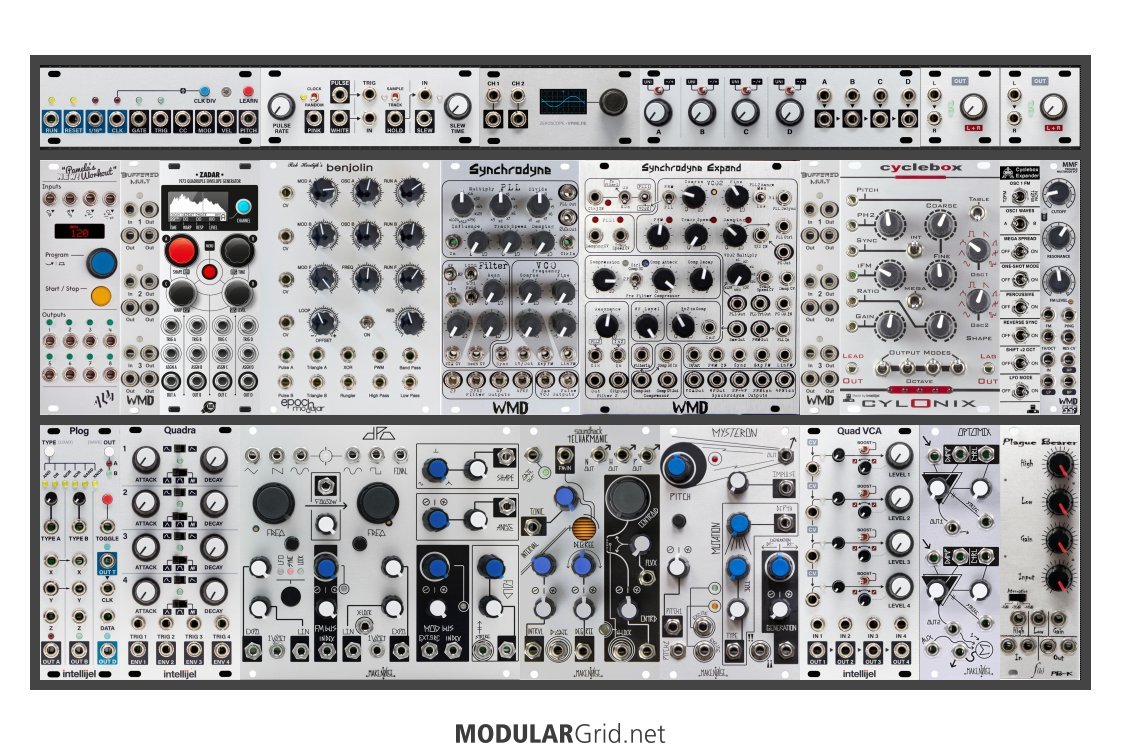Pam's IS a good choice, don't get me wrong there...but my concern is the lack of both LFOs and EGs. Your best bet is something which can combine these functions; as of late, a lot of people have been gravitating to the Xaoc Zadar, but Intellijel's new Quadrax + Qx expander might be a better choice from the standpoint that there's no menu diving involved, plus there's a lot of interesting functions there. At the same time, though, the Zadar has crazy-long cycle times that run up into the tens of minutes, plus it also fits into 13 hp with its Nin expander, while the Intellijel requires 18 for the Quadrax + its expander. More or less a "what feels better" sort of issue. Do keep the Pam's, though...as a clocking device and trigger sequencer, it's superb.
That stereo VCA...hm...you tend to see those for dynamic control on outputs, but in a rig like this, I'm wondering how useful it really is. There's other things that could be in there, especially if you swap that buffered mult (yep, there's enough CV destinations that you NEED it here) down to a 3U row and make it fit in 2 hp, which you already have open. With that gone, and after pulling the Stereo VCA and the 2 hp blank, you have 24 hp in the tile row to play with. If it were me, I'd have that row look like this:
Stereo Line In / uMIDI / Transient Modules u4R / Noise Tools / QuadrATT / Stereo Line Out
Now, what's that new u4R thing? Ahhh...another bit to go in between timing and logic. Have a look at it...makes lots of sense.
And speaking of logic, while the Plog is a really nicely-featured module, it's just the gates. You'll need a few more toys, such as comparators (which can generate gate info from CV/mod voltage curves), a diode OR for combining gates (see the Doepfer A-186-1 for an example), pulse counters which allow you to specify a trigger/gate to fire on a specific beat, maybe a derivator (something like Ladik's J-110, which fires pulses based on CV movement direction...crazy useful for tracking EGs and LFOs) or something probabilistic to screw with clocking, like Ladik's S-090. As regards the comparators, though...there's a specific type of these called a window comparator, and these allow you to output several different pulse signals as a voltage curve moves through a user-defined "window" of upper and lower thresholds. Dovemans' SHFT is a good example of these. Basically, the point of logic is to take the timing and sequential info moving around as pulsetrains, and screw with it all, while also generating more pulsetrains via comparators and the like, and then mashing all of these through a Boolean module like the Plog, et al to "smooth" the behavior between pulsetrains. Boolean logic takes a pair of incoming pulses, then subjects them to a logical test to arrive at a pulse output that happens on four specific pulse states: OR, AND, NAND, NOR. Or, more clearly...
OR: Pulses present at either input result in an output gate when both inputs do NOT concur.
AND: Pulses present at either input result in an output gate when both inputs DO concur.
...and the N states are these, but inverse. NOR (also known as XOR), for example, outputs a pulse when neither input has a high state. These tricks can be used to alter sequencer behavior, fire other events within a patch, screw with ongoing activities, etc etc etc. They open the lid on timing within a modular environment. Now, one other not-logic-but-really-it-is thing that fits here would be ratcheting, which is a triggered repetition of a pulse, usually via a sequencer. But with that pulse counter I mentioned previously, you can patch out a single clock step to fire the ratchet/clock multiplier (have a look at Doepfer's A-160-5 for reference) and get a rapid-fire pulse train with X number of pulses in subdivided time whenever that 7th beat gets fired. This is how Tangerine Dream gets those rapid repeated sequencer notes...albeit a bit simpler than you'd have to do it on Moog hardware. And it's also how you wring every bit of timing functionality out of your build!


